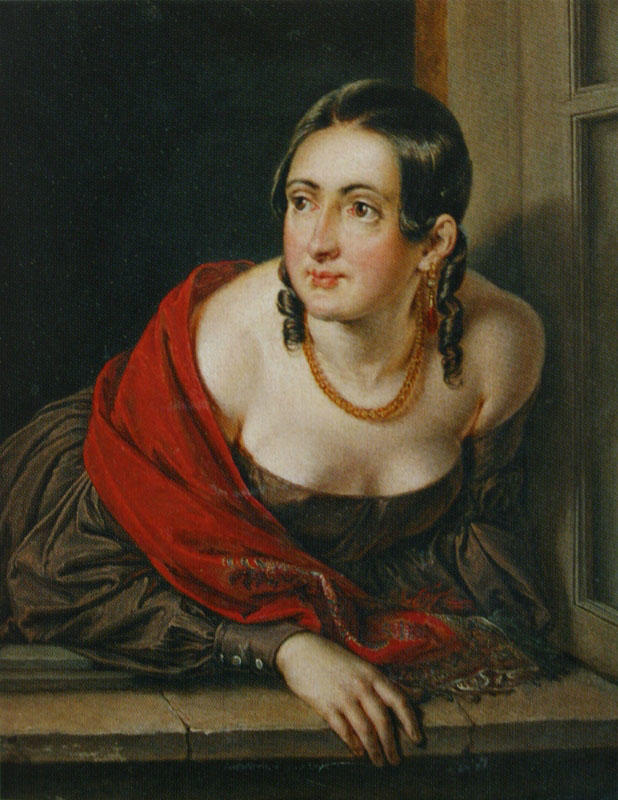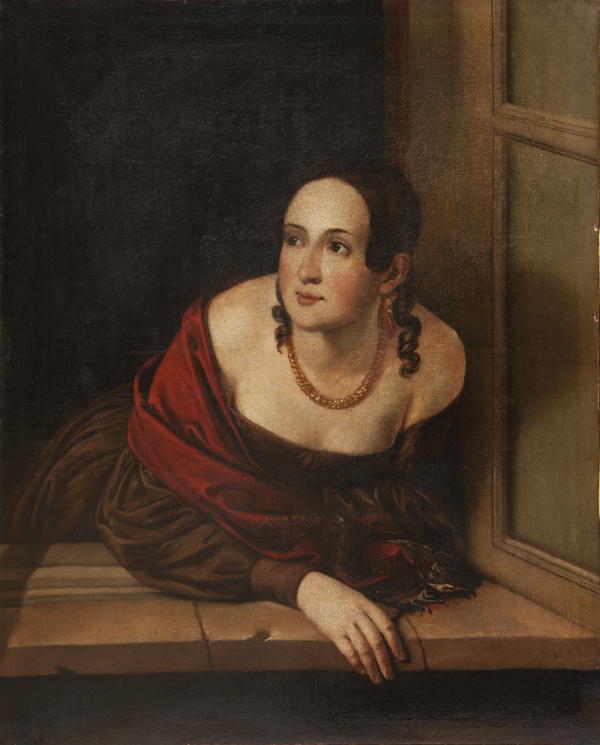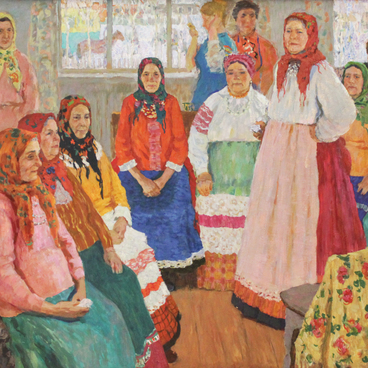The copy of the painting Woman at the Window by Russian portrait painter Vasily Tropinin entered the Tambov Regional Ethnography Museum from the Governorate Archive. It is recorded in the book of acquisitions as Portrait of a Woman. There is an assumption that this work was made by the artist’s son, painter Arseny Tropinin. He often made copies of the paintings of Tropinin Senior and even received the title of a non-class artist from the Academy of Arts for such work.
Vasily Tropinin was born in a family of serfs. His talent for painting appeared manifested itself early, the boy studied at a public school for four years. But, the landowner Count Morkov did not need artists and sent Tropinin to study confectionery in St. Petersburg. Vasily secretly attended lectures at the Academy of Arts under the auspices of Morkov’s cousin — and studied for almost six years. The artist was set free only at the age of 47, in 1823, and that same year he received the intermediate title of appointed to academics. A year later, on the instruction of the Academy, Tropinin painted a portrait of Professor Leberecht and became a full-fledged academician of portraiture.
The original painting Woman at the Window (The Treasurer’s Wife) was painted in 1841. According to legend, it was inspired by Mikhail Lermontov’s poem The Tambov Treasurer’s Wife. The latter was first published by the Sovremennik magazine in 1838, without a signature and in an abridged version. According to the plot, an uhlan regiment arrived in the provincial, boring town of Tambov for winter quarters. Avdotia, the wife of the local treasurer, an elderly, bald and unpleasant man, fell in love with a young rittmeister — one of the junior officers. One evening, the treasurer sat down to play cards with the uhlan and lost to him all his money. In the heat pf passion, he staked his wife — and lost her too. Avdotia threw her wedding ring into her husband’s face, and the delighted rittmeister, forgetting the settlement, his sabre, his hat, took the woman with him. The poem has an open ending: Lermontov did not disclose what happened to his characters after. Contemporaries praised the poem for the closely observed characters of the Russian province.
The painting depicts a joyful young woman. She looks out of the open window in waiting. On her shoulder lies a cherry shawl that looks like a silk scarf. She has earrings in her ears and an expensive necklace on her neck. Smooth lighting emphasizes the woman’s beauty and the moment of impatient curiosity.
Researchers suppose that the idea of The Tambov Treasurer’s Wife came to Lermontov when he briefly visited Tambov at the end of 1835. In January-February 1836, on the estate of his grandmother in the village of Tarkhany, he materialized the plot into a poem. Three years passed between the publication in Sovremennik and the creation of the portrait. There is no reliable proof that Tropinin depicted precisely the Tambov treasurer’s wife. The open and emotional portrait of a mature, beautiful woman, looking hopefully out the window, was liked by contemporaries. They picked up an appropriate literary plot for it, which at that time was well-known to everyone.
Vasily Tropinin was born in a family of serfs. His talent for painting appeared manifested itself early, the boy studied at a public school for four years. But, the landowner Count Morkov did not need artists and sent Tropinin to study confectionery in St. Petersburg. Vasily secretly attended lectures at the Academy of Arts under the auspices of Morkov’s cousin — and studied for almost six years. The artist was set free only at the age of 47, in 1823, and that same year he received the intermediate title of appointed to academics. A year later, on the instruction of the Academy, Tropinin painted a portrait of Professor Leberecht and became a full-fledged academician of portraiture.
The original painting Woman at the Window (The Treasurer’s Wife) was painted in 1841. According to legend, it was inspired by Mikhail Lermontov’s poem The Tambov Treasurer’s Wife. The latter was first published by the Sovremennik magazine in 1838, without a signature and in an abridged version. According to the plot, an uhlan regiment arrived in the provincial, boring town of Tambov for winter quarters. Avdotia, the wife of the local treasurer, an elderly, bald and unpleasant man, fell in love with a young rittmeister — one of the junior officers. One evening, the treasurer sat down to play cards with the uhlan and lost to him all his money. In the heat pf passion, he staked his wife — and lost her too. Avdotia threw her wedding ring into her husband’s face, and the delighted rittmeister, forgetting the settlement, his sabre, his hat, took the woman with him. The poem has an open ending: Lermontov did not disclose what happened to his characters after. Contemporaries praised the poem for the closely observed characters of the Russian province.
The painting depicts a joyful young woman. She looks out of the open window in waiting. On her shoulder lies a cherry shawl that looks like a silk scarf. She has earrings in her ears and an expensive necklace on her neck. Smooth lighting emphasizes the woman’s beauty and the moment of impatient curiosity.
Researchers suppose that the idea of The Tambov Treasurer’s Wife came to Lermontov when he briefly visited Tambov at the end of 1835. In January-February 1836, on the estate of his grandmother in the village of Tarkhany, he materialized the plot into a poem. Three years passed between the publication in Sovremennik and the creation of the portrait. There is no reliable proof that Tropinin depicted precisely the Tambov treasurer’s wife. The open and emotional portrait of a mature, beautiful woman, looking hopefully out the window, was liked by contemporaries. They picked up an appropriate literary plot for it, which at that time was well-known to everyone.




